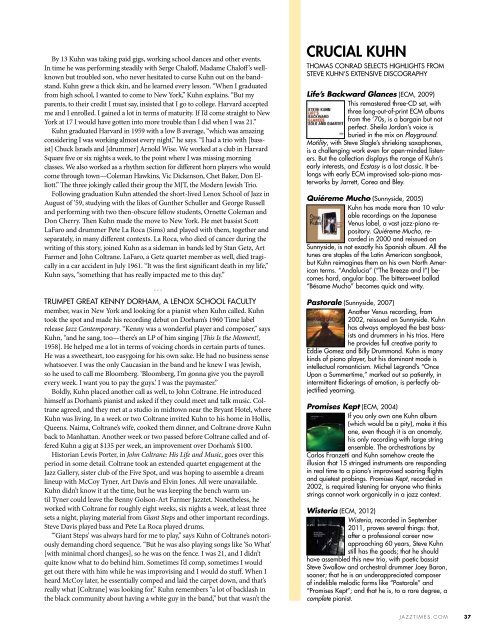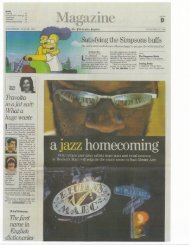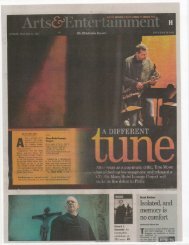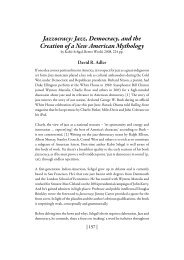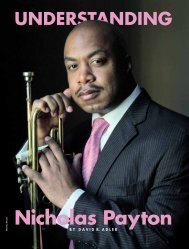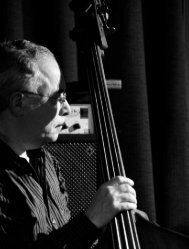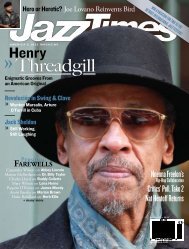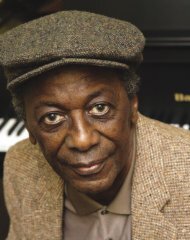Create successful ePaper yourself
Turn your PDF publications into a flip-book with our unique Google optimized e-Paper software.
By 13 Kuhn was taking paid gigs, working school dances and other events.In time he was performing steadily with Serge Chaloff, Madame Chaloff ’s wellknownbut troubled son, who never hesitated to curse Kuhn out on the bandstand.Kuhn grew a thick skin, and he learned every lesson. “When I graduatedfrom high school, I wanted to come to New York,” Kuhn explains. “But myparents, to their credit I must say, insisted that I go to college. Harvard acceptedme and I enrolled. I gained a lot in terms of maturity. If I’d come straight to NewYork at 17 I would have gotten into more trouble than I did when I was 21.”Kuhn graduated Harvard in 1959 with a low B average, “which was amazingconsidering I was working almost every night,” he says. “I had a trio with [bassist]Chuck Israels and [drummer] Arnold Wise. We worked at a club in HarvardSquare five or six nights a week, to the point where I was missing morningclasses. We also worked as a rhythm section for different horn players who wouldcome through town—Coleman Hawkins, Vic Dickenson, Chet Baker, Don Elliott.”The three jokingly called their group the MJT, the Modern Jewish Trio.Following graduation Kuhn attended the short-lived Lenox School of Jazz inAugust of ’59, studying with the likes of Gunther Schuller and George Russelland performing with two then-obscure fellow students, Ornette Coleman andDon Cherry. Then Kuhn made the move to New York. He met bassist ScottLaFaro and drummer Pete La Roca (Sims) and played with them, together andseparately, in many different contexts. La Roca, who died of cancer during thewriting of this story, joined Kuhn as a sideman in bands led by Stan Getz, ArtFarmer and John Coltrane. LaFaro, a Getz quartet member as well, died tragicallyin a car accident in July 1961. “It was the first significant death in my life,”Kuhn says, “something that has really impacted me to this day.”…Trumpet great Kenny Dorham, a Lenox School facultymember, was in New York and looking for a pianist when Kuhn called. Kuhntook the spot and made his recording debut on Dorham’s 1960 Time labelrelease Jazz Contemporary. “Kenny was a wonderful player and composer,” saysKuhn, “and he sang, too—there’s an LP of him singing [This Is the Moment!,1958]. He helped me a lot in terms of voicing chords in certain parts of tunes.He was a sweetheart, too easygoing for his own sake. He had no business sensewhatsoever. I was the only Caucasian in the band and he knew I was Jewish,so he used to call me Bloomberg. ‘Bloomberg, I’m gonna give you the payrollevery week. I want you to pay the guys.’ I was the paymaster.”Boldly, Kuhn placed another call as well, to John Coltrane. He introducedhimself as Dorham’s pianist and asked if they could meet and talk music. Coltraneagreed, and they met at a studio in midtown near the Bryant Hotel, whereKuhn was living. In a week or two Coltrane invited Kuhn to his home in Hollis,Queens. Naima, Coltrane’s wife, cooked them dinner, and Coltrane drove Kuhnback to Manhattan. Another week or two passed before Coltrane called and offeredKuhn a gig at $135 per week, an improvement over Dorham’s $100.Historian Lewis Porter, in John Coltrane: His Life and Music, goes over thisperiod in some detail. Coltrane took an extended quartet engagement at theJazz Gallery, sister club of the Five Spot, and was hoping to assemble a dreamlineup with McCoy Tyner, Art Davis and Elvin Jones. All were unavailable.Kuhn didn’t know it at the time, but he was keeping the bench warm untilTyner could leave the Benny Golson-Art Farmer Jazztet. Nonetheless, heworked with Coltrane for roughly eight weeks, six nights a week, at least threesets a night, playing material from Giant Steps and other important recordings.Steve Davis played bass and Pete La Roca played drums.“‘Giant Steps’ was always hard for me to play,” says Kuhn of Coltrane’s notoriouslydemanding chord sequence. “But he was also playing songs like ‘So What’[with minimal chord changes], so he was on the fence. I was 21, and I didn’tquite know what to do behind him. Sometimes I’d comp, sometimes I wouldget out there with him while he was improvising and I would do stuff. When Iheard McCoy later, he essentially comped and laid the carpet down, and that’sreally what [Coltrane] was looking for.” Kuhn remembers “a lot of backlash inthe black community about having a white guy in the band,” but that wasn’t theCrucial KuhnThomas Conrad selects highlights fromSteve Kuhn’s extensive discographyLife’s Backward Glances (ECM, 2009)This remastered three-CD set, withthree long-out-of-print ECM albumsfrom the ’70s, is a bargain but notperfect. Sheila Jordan’s voice isburied in the mix on Playground.Motility, with Steve Slagle’s shrieking saxophones,is a challenging work even for open-minded listeners.But the collection displays the range of Kuhn’searly interests, and Ecstasy is a lost classic. It belongswith early ECM improvised solo-piano masterworksby Jarrett, Corea and Bley.Quiéreme Mucho (Sunnyside, 2005)Kuhn has made more than 10 valuablerecordings on the JapaneseVenus label, a vast jazz-piano repository.Quiéreme Mucho, recordedin 2000 and reissued onSunnyside, is not exactly his Spanish album. All thetunes are staples of the Latin American songbook,but Kuhn reimagines them on his own North Americanterms. “Andalucia” (“The Breeze and I”) becomeshard, angular bop. The bittersweet ballad“Bésame Mucho” becomes quick and witty.Pastorale (Sunnyside, 2007)Another Venus recording, from2002, reissued on Sunnyside. Kuhnhas always employed the best bassistsand drummers in his trios. Herehe provides full creative parity toEddie Gomez and Billy Drummond. Kuhn is manykinds of piano player, but his dominant mode isintellectual romanticism. Michel Legrand’s “OnceUpon a Summertime,” marked out so patiently, inintermittent flickerings of emotion, is perfectly objectifiedyearning.Promises Kept (ECM, 2004)If you only own one Kuhn album(which would be a pity), make it thisone, even though it is an anomaly,his only recording with large stringensemble. The orchestrations byCarlos Franzetti and Kuhn somehow create theillusion that 15 stringed instruments are respondingin real time to a piano’s improvised soaring flightsand quietest probings. Promises Kept, recorded in2002, is required listening for anyone who thinksstrings cannot work organically in a jazz context.Wisteria (ECM, 2012)Wisteria, recorded in September2011, proves several things: that,after a professional career nowapproaching 60 years, Steve Kuhnstill has the goods; that he shouldhave assembled this new trio, with poetic bassistSteve Swallow and orchestral drummer Joey Baron,sooner; that he is an underappreciated composerof indelible melodic forms like “Pastorale” and“Promises Kept”; and that he is, to a rare degree, acomplete pianist.jazztimes.com 37


